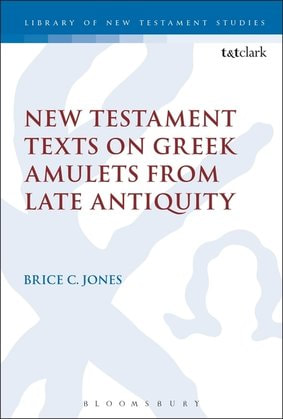|
The Review of Biblical Literature (RBL) has just published a review of my book, authored by New Testament scholar and textual critic, Prof. Juan Hernández, Jr. (Bethel University). The four page review captures very well the intentions of the project and I want to thank Prof. Hernández for such a kind review. RBL is paywalled, but I extract a couple paragraphs below. “With this book, the rationale for the exclusion of a select, carefully edited, and, by all counts, textually “meritorious” collection of amulets from the task of textual reconstruction has been eliminated. The writing, so to speak, was already on the wall. Studies have highlighted the value of noncontinuous manuscripts for textual criticism for some time now. That writing, however, moves toward fulfillment with the publication of Brice Jones’s New Testament Texts on Greek Amulets from Late Antiquity, the first systematic attempt to model how nontraditional artifacts can serve as bona fide witnesses to the Greek New Testament. What remains is a matter of will.”
“Brice Jones’s New Testament Texts on Greek Amulets from Late Antiquity is thus an undeniably exacting and captivating study that successfully models how a particular class of noncontinuous manuscripts—amulets—can serve as witnesses for understanding the textual history of the Greek New Testament and contribute to its textual reconstruction. Social artifacts are effectively transformed into textual artifacts in this study with considerable yields. The investigation is a model for how such work should be undertaken in the future. The assembled database is also of clear, independent value, irrespective of the book’s conclusions. The material is, in substance, above reproach, and any concerns that emerge are a matter of circumstance.” “But the greater irony emerges from what New Testament Texts on Greek Amulets from Late Antiquity does so well, and for which it justifiably receives high marks: the transformation of a social artifact into a textual one. The task requires a commitment to a form of extraction that detracts from the artifact’s original function. Amulets are thus stripped of their humanity, with their record of the hopes, dreams, fears, anxieties, and superstitions of the ancient supplicant, for a “higher” purpose. They are mined for a handful of Greek letters--voces magicae—in order to find correspondence with, and contribute to, a reconstructed text, the Greek New Testament. That text, however, is not a simple textual artifact. It is also a social artifact, and it too requires the right words, the right rituals, and the right ritual specialists.”
0 Comments
|
Archives
December 2020
Categories
All
|
